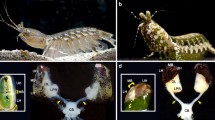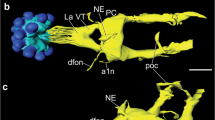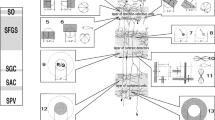Summary
Neuronal elements, i.e. first and second order neurons, of the first optic ganglion of three waterbugs, N. glauca, C. punctata and G. lacustris, are analyzed on the basis of light and electron microscopy.
Eight retinula cell axons, leaving each ommatidium, disperse to different cartridges as they enter the laminar outer plexiform layer. Such a pattern of divergence is one of the conditions for neuronal superposition; it is observed for all three species of waterbugs. The manner in which the receptors of a single bundle of ommatidia split of within the lamina, whereby information from receptors up to three or five horizontal rows away can converge upon the same cartridge, differs among the species. Six of the eight axons of retinula cells R1-6, the short visual fibers end at different levels within the bilayered lamina, whereas the central pair of retinula cells R7/8, the long visual fibers, run directly through the lamina to a corresponding unit of the medulla. Four types of monopolar cells L1–L4 are classified; their branching patterns seem to be correlated to the splitting and termination of retinula cell axons. The topographical relationship and synaptic organization between retinula cell terminals and monopolar cells in the two laminar layers are identified by examination of serial ultrathin sections of single Golgi-stained neurons.
An attempt is made to correlate some anatomical findings, especially the neuronal superposition, to results from physiological investigations on the hemipteran retina.
Similar content being viewed by others
References
Armett-Kibel, Ch., Meinertzhagen, I.A. and Dowling, J.E.: Cellular and synaptic organization in the lamina of the dragon-fly Sympetrum rubicundulum. Proc. R. Soc. Lond. [Biol.] 196, 385–413 (1977)
Boschek, C.B.: On the fine structure of the peripheral retina and lamina ganglionaris of the fly, Musca domestica. Z. Zellforsch. 118, 369–409 (1971)
Braitenberg, V.: Patterns of projection in the visual system of the fly. I. Retina-lamina projections. Exp. Brain Res. 3, 271–297 (1967)
Braitenberg, V., Debbage, P.: A regular net of reciprocal synapses in the visual system of the fly, Musca domestica. J. Comp. Physiol. Psychol. 90, 25–31 (1974)
Colonnier, M.: The tangential organization of the visual cortex. J. Anat. 98, 327–344 (1964)
Eckert, M.: Hell-Dunkel-Adaptation in aconen Appositionsaugen der Insekten. Zool. Jb. Physiol. 74, 102–120 (1968)
Horridge, G.A.: A note on the number of retinula cells of Notonecta. Z. vergl. Phys. 61, 259–262 (1968)
Ioannides, A.C., Horridge, G.A.: The organization of visual fields in hemipteran acone eye. Proc. R. Soc. Lond. [Biol.] 190, 373–391 (1975)
Karnovsky, M.J.: A formaldehyde-glutaraldehyde fixative of high osmolarity for use in electron microscopy. J. Cell Biol. 27, 137A (1965)
Kirschfeld, K.: Die Projektion der optischen Umwelt auf das Raster der Rhabdomere im Komplexauge von Musca. Exp. Brain Res. 3, 248–270 (1967)
Lüdtke, H.: Retinomotorik und Adaptationsvorgänge im Auge des Rückenschwimmers (Notonecta glauca L.). Z. vergl. Phys. 35, 129–152 (1953)
Meinertzhagen, I.A.: The first and second neural projection of the eye. Ph. D. Thesis, University of St. Andrews (Scotland) 1971
Nässel, D.R.: The organization of the lamina ganglionaris of the prawn, Pandalus borealis (Kröyer). Cell Tissue Res. 163, 445–464 (1975)
Nässel, D.R.: The retina and retinal projection on the lamina ganglionaris of the crayfish Pacifastacus leniusculus (Dana). J. Comp. Neurol. 167, 341–360 (1976)
Ohly, K.P.: The neurons of the first synaptic region of the optic neuropile of the firefly, Phausis splendidula L. (Coleoptera). Cell Tissue Res. 158, 89–109 (1975)
Rensing, L.: Beiträge zur vergleichenden Morphologie, Physiologie und Ethologie der Wasserläufer (Gerroidea). Zool. Beitr. 7, N.F. 447–485 (1962)
Ribi, W.A.: The neurons of the first optic ganglion of the bee, Apis mellifera. Adv. Anat. 50, 4, 1–43 (1975a)
Ribi, W.A.: The first optic ganglion of the bee. I. Correlation between visual cell types and their terminals in the lamina and medulla. Cell Tissue Res. 165, 103–111 (1975b)
Ribi, W.A.: The first optic ganglion of the bee. II. Topographical relationships of the monopolar cells within and between cartridges. Cell Tissue Res. 171, 359–373 (1976)
Schneider, L., Langer, H.: Die Struktur des Rhabdoms im “Doppelauge” des Wasserläufers Gerris lacustris. Z. Zellforsch. 99, 358–559 (1969)
Stowe, S., Ribi, W.A., Sandemann, D.C.: The organisation of the lamina ganglionaris of the crabs Scylla serrata and Leptograpsus variegatus. Cell Tissue Res. 178, 517–532 (1977)
Strausfeld, N.J.: Atlas of an insect brain. Berlin-Heidelberg-New York: Springer 1976
Strausfeld, N.J., Braitenberg, V.: The compound eye of the fly (Musca domestica): Connections between cartridges of the lamina ganglionaris. Z. vergl. Phys. 70, 95–104 (1970)
Strausfeld, N.J., Campos-Ortega, J.A.: The L4 monopolar neuron: A substrate for lateral interaction in the visual system of the fly Musca domestica (L.). Brain Res. 59, 97–117 (1973)
Wachmann, E.: Vergleichende Analyse der feinstrukturellen Organisation offener Rhabdome in den Augen der Cucujiformia (Insecta, Coleoptera), unter besonderer Berücksichtigung der Chrysomelidae. Zoomorph. 88, 95–131 (1977)
Walcott, B.: Movement of retinula cells in insect eyes on light adaptation. Nature 223, 971–972 (1969)
Walcott, B.: Cell movement on light adaptation in the retina of Lethocerus (Belostomatidae, Hemiptera). Z. vergl. Phys. 74, 1–16 (1971a)
Walcott, B.: Unit studies on receptor movement in the retina of Lethocerus (Belostomatidae, Hemiptera). Z. vergl. Phys. 74, 17–25 (1971b)
Wolburg-Buchholz, K.: The superposition eye of Cloeon dipterum: The organization of the lamina ganglionaris. Cell Tissue Res. 177, 9–28 (1977)
Author information
Authors and Affiliations
Rights and permissions
About this article
Cite this article
Wolburg-Buchholz, K. The organization of the lamina ganglionaris of the hemipteran insects, Notonecta glauca, Corixa punctata and Gerris lacustris . Cell Tissue Res. 197, 39–59 (1979). https://doi.org/10.1007/BF00233552
Accepted:
Issue Date:
DOI: https://doi.org/10.1007/BF00233552




